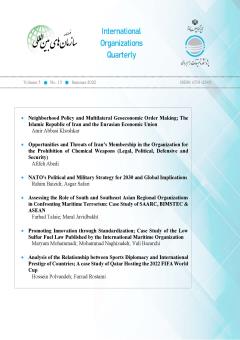NATO's Political and Military Strategy for 2030 and Global Implications
Subject Areas : Politics
Rahim Baizidi
1
![]() ,
Asgar Safari
2
,
Asgar Safari
2
1 -
2 -
Keywords: NATO, Strategy, Strategic Concept, Threat, Geopolitics,
Abstract :
The dynamic nature of the international order and distribution of power has transformed the international environment into an arena of rapid political, military, and security developments. The establishment of NATO was also the result of one of these developments, including rapid expansion of Soviet's military and geopolitical power. The organization has faced many challenges throughout its life, one of the most important of which was the collapse of the Soviet Union and the disappearance of its founding philosophy. But in the post-Cold War era of international relations, NATO not only sustained its life by relying on its strategic concepts, using Russia's in its domestic power transition, as well as highlighting emerging threats such as terrorism, but also increased its members from 16 countries -before the collapse of the Soviet Union- to 30 countries in 2020. Despite NATO's high level of adaptation to international developments, the global distribution of power is changing rapidly, posing fundamental challenges to the organization. The present study seeks to address three key issues, including the challenges and threats facing NATO in assessing the international political and security environment, NATO's strategy for dealing with these threats, and finally its consequences. Using a descriptive-analytical method, while extracting the system of threats facing NATO, this article deals with some of the most important pillars of NATO's strategy for implementation until 2030. Finally, the global implications of NATO's new strategy are analyzed as well.
بایزیدی، رحیم (1400). استراتژیهای بخشی و رژیمهای ژئوپلیتیکی، ژئواکونومیکی و ژئوکالچری آمریکا در نظمسازی جهانی و منطقهای، فصلنامه سیاست جهانی، 10 (2)، (پیاپی 36)، صص 31-60.
کیانی، علیاکبر (1398). وضعیت منافع ایران در رابطه با رویکردهای امنیتی اتحادیه اروپا به ناتو، فصلنامه روابط خارجی، 11 (41)، صص 139-160.
غلامی، بهادر (1398). تغییرات اقلیمی؛ ظهور و تشدید بحرانهای فراگیر امنیتی بینالمللی، فصلنامه روابط خارجی، ۱۱ (43)، صص 5-36.
مطلبی، مسعود. غلامی، مجید (1394). رهيافت «امنيتي سازي» سازمان پيمان آتلانتيك شمالي (ناتو) و جمهوري اسلامي ايران، فصلنامه تخصصي علوم سياسي، (12، 35)، صص 53-77.
Bergmann, M. Cicarelli, S. (2021). NATO’s Financing Gap Why NATO Should Create Its Own Bank, Center for American Progress.
Bocse, A.-M. (2020). NATO, energy security and institutional change. European Security, 1–20.
Marrone, A. (2011). The Equilibrium of the 2010 NATO Strategic Concept. The International Spectator, 46(3), 93–111.
Oertel, J. (2019). V. NATO’s China Challenge. Whitehall Papers, 95(1), 67–8.
Trenin, D. (2021), Why Russia Officially Broke With NATO, Carnegie Endowment for International Peace, Aveliable at: https:// carnegie moscow. org/ 2021/10/20/why-russia-officially-broke-with-nato-pub-85611.
Erlanger, S. Shear. M.D. (2021), Shifting Focus, NATO Views China as a Global Security Challenge, The New yourk times, Aveliable at: https:// www. nytimes.com/2021/06/14/world/europe/biden-nato-china-russia.html.
Ellehuus, R. Morcos, P. (2021), lifting up Our Values at Home’: How to Revitalize NATO’s Political Cohesion, the Center for Strategic and International Studies, https://www.csis.org/analysis/lifting-our-values-home-how-revitalize-natos-political-cohesion..
Odehnal, J., Neubauer, J., Olejníček, A., Boulaouad, J., & Brizgalová, L. (2021). Empirical Analysis of Military Expenditures in NATO Nations. Economies, 9(3), 107.
Resilience through Civil Preparedness A CCOE Info Sheet, (2019), Civil-Military Cooperation Centre of Excellence, Aveliable at: https://www. cimic- coe. org/ resources/ fact- sheets/ resilience- through- civil-preparedness. pdf .
Kowalski, A. M. (2020). Dynamics and factors of innovation gap between the European Union and China. Journal of the Knowledge Economy, 1-16.
Causevic, A. (2017). Facing an unpredictable threat: is NATO ideally placed to manage climate change as a non-traditional threat multiplier? Connections, 16(2), 59-80.
Bloch, A. Goldgeier, J. (2021), Finding right role for NATO in addressing china and climate change, the Center on the United States and Europe, the Brookings Institution.
Santana, M. (2021), Defence Innovation Accelerator for the North Atlantic (DIANA), Aveliable at: https://finabel.org/defence-innovation-accelerator- for-the-north-atlantic-diana/ .
NATO, (2021), what is NATO doing to counter the threat of terrorism? Aveliable at: https://www.nato.int/cps/en/natohq/news_185728.htm.
NATO. (2021), Arms control, disarmament and non-proliferation in NATO, Aveliable at: https://www.nato.int/cps/en/natohq/topics_48895.htm.
Rosén, F. (2020), NATO, Cultural Property and the International Protection Gap, In, Protecting Civilians A Humanitarian Obligation Essay Series on the Protection of Civilians, Children and Armed Conflict and Cultural Property Protection, NATO publishing.
NATO, (2021), NATO’s response to hybrid threats, Aveliable at: https:// www.nato.int/cps/en/natohq/topics_156338.htm .
Lundquist, E. (2021), NATO Learns Lessons from COVID-19 Crisis, National defense, Aveliable at: https://www.nationaldefensemagazine. org/ articles/2021/8/30/nato-learns-lessons-from-covid-19-crisis.
Coffey, L. Kochis, D. (2021), The U.S. Must Defend NATO’s Open-Door Policy at the 2021 Brussels Summit, The heritage foundation, issue brief, No.6084.
Cornish, P. (1999). A Strategic Concept for the Twenty-first Century. Defense Analysis, 15(3), 241–260.
Paynter, A. (2011), Libya: Evaluating NATO’s Strategic Concept, The Manohar Parrikar Institute for Defence Studies and Analyses (MP-IDSA), Aveliable at: https://www.idsa.in/idsacomments/Libya Evaluating NATOsStrategicConcept_apaynter_060711
Ferreira, J. J., Raposo, M. L., & Mainardes, E. W. (2014). Strategy and strategic management concepts: are they recognised by management students? Economics and Management. 1, XVII.
Jakobsen, P.V. (2011), NATO’s Comprehensive Approach after Lisbon: Principal Problem Acknowledged, Solution Elusive, In NATO new strategic concept: a comprehensive assessment, Danish Institute for International Studies
Interim National Security Strategic Guidance, (2021), the White House, available at: https://www.whitehouse.gov/wp-content/uploads/ 2021/03/ NSC-1v2.pdf.
Kecskeméthy, K. S. (2021). The NATO 2030 Report. Strategic Priorities of the Alliance. In International conference KNOWLEDGE-BASED ORGANIZATION (Vol. 27, No. 1, pp. 118-124.
Kamp, K. (2016), Why NATO Needs a New Strategic Concept, NATO Defense College, NDC Research Report.
Marrone, A. (2011). The Equilibrium of the 2010 NATO Strategic Concept. The International Spectator, 46(3), 93–111.
National Security Strategy of the United States of America (2017), the White House, available at: https://trumpwhitehouse.archives.gov/wp-content/ uploads/2017/12/NSS-Final-12-18-2017-0905.pdf
NATO Enlargement & Open Door, (2016), North Atlantic Treaty Organization fact sheet, available at: https://www.nato.int/nato_static_fl2014/assets/ pdf/pdf_2016_07/20160627_1607-factsheet-enlargement-eng.pdf.
NATO Green Defense Framework. (2014). NATO Organization, available at: https://natolibguides.info/smartenergy/documents.
NATO summit statement: ‘We call on Iran to stop all ballistic missile activities, (2021), Arab news, available at: https://www.arabnews.com/node/ 1876506/ middle-east


